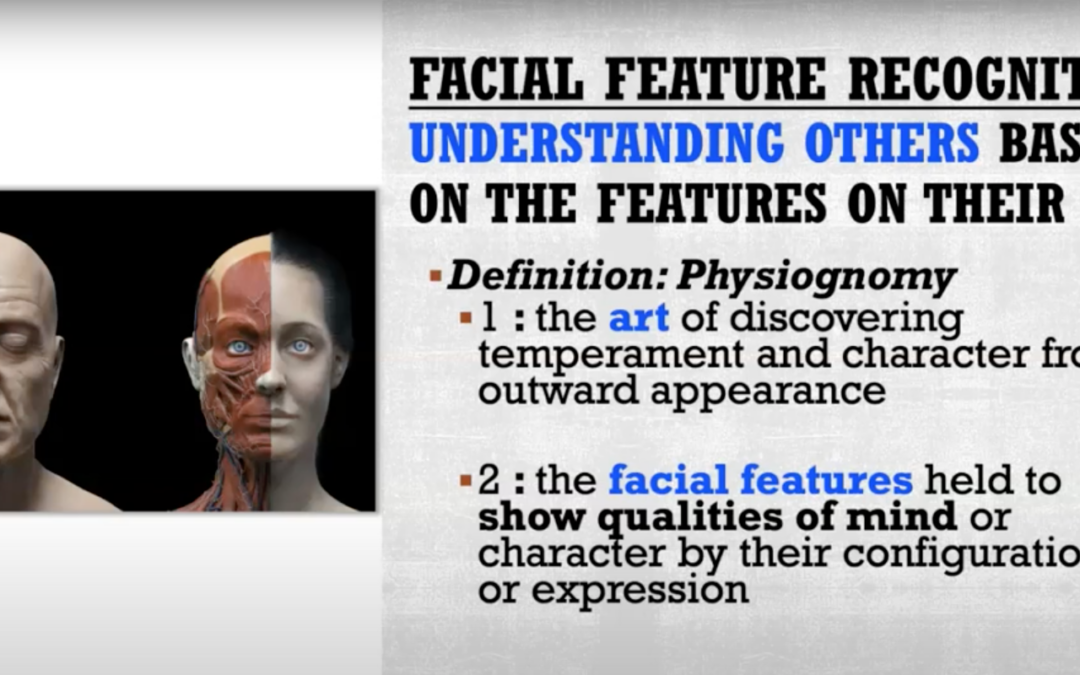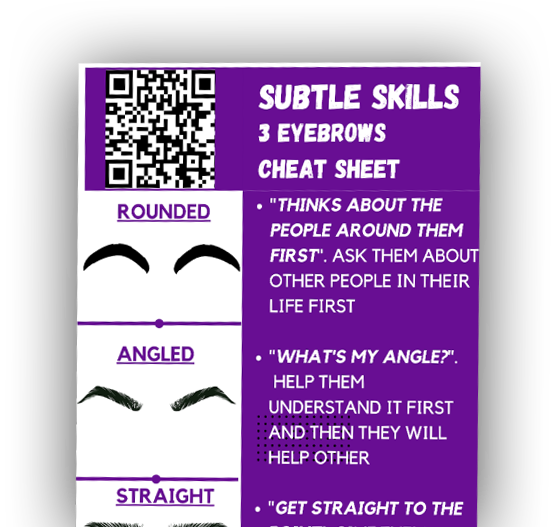The question that we get asked about the most is… “Can you tell me a little bit about the history behind face reading? Because I have never heard of it before?” Well, face reading is based on what’s called physiognomy, which is the art of understanding a person based on their temperament, and character based on their outward appearance. So if you take a look at the picture you’ll see you have the outer layer of skin and the muscles that are underneath that. Well, how do those two play together in the face? What happens is the mind creates movement and movement creates muscle. So our face is a hundred percent based on our genetics, but what happens is the next layer down, which is epigenetics. So epigenetics is your left brain and right brain and how they take in all the experiences that you have in life.
And so it’s what happens to you, how perceive that event and how you ponder on that event. And what happens is depending on if it’s taken in by a left brain, right brain feature, then it can actually make small adjustments over time. So that’s why you can have identical twins who grew up in the same house raised by the same parents who went to the same schools. But when you look at their face, you’ll find subtle differences in their facial features and people go, “how long has this been around for?” Well, all the way back to 500 BC is where you can trace face reading. In the beginnings of it, Pythagoras studied it, Aristotle studied it. But it kind of disappeared for a while and it hit probably the highlight in terms of popularity in the 1700’s with Lavator, it was a little more mainstream at the time it was taught in schools.
Well, several different things occurred. One is that royalty didn’t like the idea that the common man can understand royalty and basically read people’s faces. It was kind of one of those things where people wanted to remain guarded. But what also happened is at the same time, a very popular pseudoscience came out and that was called phenology. So phenology is bumps on the head and they used to believe just if somebody came and felt the bumps on your head, they could tell you about your character and your mental abilities, including if are you a criminal based on the bumps on your forehead. So unfortunately because the head is close to the face, those things were lumped together. And when the pseudoscience of phenology was discredited out the door went face reading or physiognomy as well. Well, who studied it and during those times and who studied it even now, well artists, authors and attorneys study it. So why artists? Artists had to know how to draw and create a character. So it’s one thing if you are painting somebody and you’re doing a portrait, well, you’re just copying that person’s facial features. However, when you’re actually creating something from scratch, you had to know how to draw certain characteristics. So if you go and look at a lot of comic books or older paintings, all villains had angled features, angled eyebrows, angled nose, downturn nose, pointy chin. Authors had to take classes because they had a harder job then. You see, before you could take modern photos and put it in your books, you had to be able to describe your characters to such a degree that your readers could mentally picture who they were. So you couldn’t just talk about their actions. You had to mention things like as he raised his furrowed brow, while you’re reading through the book. So that the person reading it was actually picturing the character in the way that the author had hoped. And last but not least, we talked about attorneys, well for jury consulting, what can you see? Can you see a little bit of body language? However, you can see somebody’s facial features. So it’s still used today in jury selection. It’s also taught at sales teams. It’s taught for networking for coworkers, trying to build team bonding. So there’s an entire litany of things that face reading can be used for.
So how come I’ve still never heard of it? There’s only a handful of books. The very first book I got what was called The Amazing Face Reading by Mac Fulfer. And I went and studied Mac’s book with highlighters and everything else. And then I found other face reading books as well. But a majority of the face reading books are more of Chinese medicine. How when you look at somebody’s face, you can understand what may be going on with their organs or what may be going on internally. So it’s very limited. I’m one of maybe a hundred to 120 people who’ve been certified in the world on how to teach facial feature recognition aka face reading. Now Mac being that he was an attorney who twisted his knee, started studying up on phenology, thus created the book.
It was such a popular concept that he was actually able to get it added to TCU or Texas Christian University as a continuing education class. So people could study it at night. And then Mac travels all around the world. Much like I do to help teach this to others. People ask all the time, how long does it take before I can start using this skill? The minute you start a module where we cover a facial feature, you can go immediately out and start using that in public. The thing is, you’re not going to walk up to people and say, “oh, I’m face reading is this true?” You can start with yourself. What a lot of people do is they actually go up to a mirror and practice. And they look and start to read their own facial features. And then they go out in public or they can do it with friends and family. You can go just find a picture of someone and start slowly studying eyebrows, nose, eyes, mouth, but it’s literally something that you can study one feature today and walk out and take it to the world immediately. And that’s what I love about face reading
About The Author:
Brian Galke’s niche is in teaching Facial Feature Analysis, a proactive skill that helps you understand people in a whole new way!
Taking the time to read someone’s face gives them the time and attention we deserve. This is a skill that’s dissipated with the distractions of modern technology. Learning how to Analyze Faces will help you make stronger connections.
Once we learn to read faces, we learned how to speak other people’s language. Taking that extra second to think “How would we best receive this?” makes it about connection, instead of thinking about what you want to say.
Contact Brian through his company Subtle Skills to arrange speaking, consulting or online virtual training.


